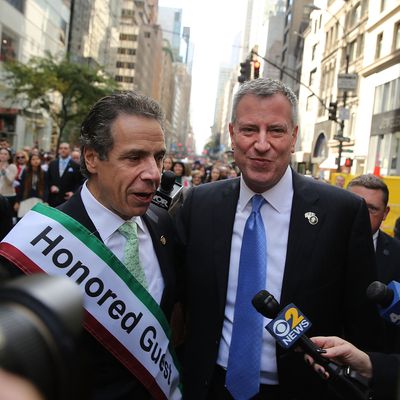
The governor accuses the mayor of concocting a “sweetheart deal” for real-estate developers. The mayor slams the governor as “disingenuous.” And driving the war of words between Andrew Cuomo and Bill de Blasio has been a twisted fraternal-political rivalry. “In Cuomo’s mind, de Blasio has forgotten who’s the governor,” a Democrat who has worked with both men says. “From de Blasio’s standpoint, it’s ‘Goddamn it, Andrew doesn’t realize I’m not his staffer anymore!’”
All highly entertaining. This shin-kicking contest, though, comes with significant consequences, especially for the city’s public school students and rent-stabilized tenants. And the wider fallout could shape the state’s politics for years.
First, some of the wonkier policy stuff. Three big items are due to expire this month in Albany: Mayoral control of the city’s public schools, apartment rent rules, and the 421-a program that subsidizes the building of new apartments.
Cuomo and de Blasio are, mercifully, in agreement on a three-year extension of mayoral control of the schools, which has been approved by the Democratic-majority state Assembly. The obstacle is the Republican majority in the state Senate, which is floating a one-year renewal, in part to pay back de Blasio for trying to elect a Democratic Senate majority last fall. The chances of the rules vaporizing completely at the end of June are slim — though if they did, the city’s school system could be plunged back into the messy era of 32 local boards running the show.
The rent regulation clock runs out on June 15. De Blasio has proposed changes including ending “vacancy decontrol,” which allows an apartment to become market-rate after the rent passes $2,500, and making rent increases from renovation costs temporary instead of permanent. Cuomo’s position is fuzzier, but he isn’t exaggerating when he says “mayhem and chaos” would ensue from letting the rules expire: Approximately 2.5 million New Yorkers live in rent-stabilized units. And merely rolling over the existing rules, a de Blasio aide says, would be “disastrous,” because about 8,000 affordable apartments are lost each year when their rents rise above the stabilization threshold.
The most contentions subject, though, is 421-a, the tax abatement program for new construction — because that’s where the real money and political power are. De Blasio crafted a plan with a surprising partner, the Real Estate Board of New York. It would extend the tax waiver from 15 or 25 years to 35, in exchange for dictating that more below-market-rate apartments be built in more parts of the city. That deal is crucial to de Blasio’s drive to add 200,000 affordable units to the city’s housing stock.
Cuomo has denounced this as a “giveaway” worth “billions and billions” to developers, and says de Blasio’s plan won’t create enough low-rent units. The governor’s not wrong about the tax dollars involved — but his shots at developers are highly opportunistic, if not downright ironic. The real-estate industry has been the most prolific donor to Cuomo’s campaigns. Preet Bharara’s investigations have made real-estate industry influence a sore subject, though, and the governor is creating a bit of daylight between himself and developers. Cuomo has also stroked construction unions and the left by saying 421-a reform should include “prevailing wages” for laborers — and put populist de Blasio in the uncomfortable spot of claiming those raises would be too costly.
Otherwise the governor has been vague on how he would alter 421-a, except that he too wants it to produce more inexpensive apartments. “There is a negotiation to take place,” he said on Susan Arbetter’s radio show.
De Blasio, too, dialed down the rhetoric this week. But City Hall is going to continue to try to find ways to apply pressure, attempting to make it painful for Albany to do nothing beyond extending, unchanged, the three programs. Those maneuvers will include rallying support from the city’s African-American and Latino pols and community leaders, plus business groups — constituencies where Cuomo has a special sensitivity. A side benefit to the effort is that it pre-emptively assigns blame. “If Albany is going to do nothing,” a de Blasio ally says, “it’s good for the mayor to be vocal and remind folks where the decisions are being made — or not being made.”
But it’s what de Blasio chooses to do after the current confrontation that might create larger headaches for Cuomo. If the mayor’s frustration with the governor hardens, he could marshal his progressive allies and Cuomo’s political antagonists into a liberal coalition that consistently opposes the governor in Albany. De Blasio might even gain some support from the real-estate industry, if it emerges from the 421-a battle disenchanted with the governor.
The mayor would effectively be giving up on getting much from Albany for the next year. But with Democrats likely to seize control of the state Senate in the 2016 elections, de Blasio would be set up to go around Cuomo and get much of what he wanted from Albany in 2017 – just in time for his own re-election campaign. And by then, with this spring’s spat as a turning point, any pretense of a friendship between the mayor and the governor would be long gone.





























